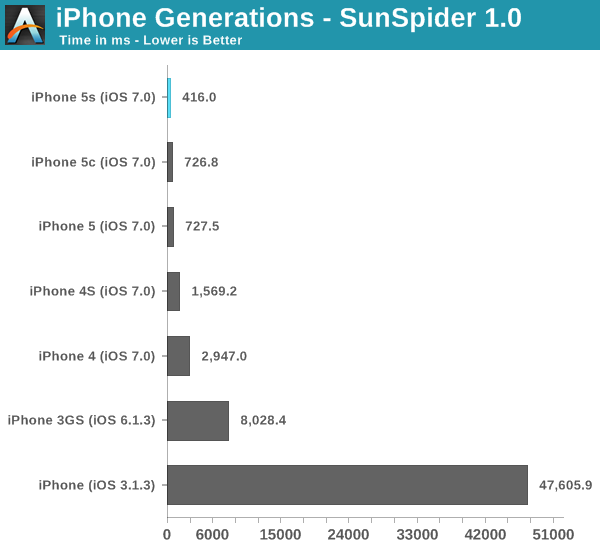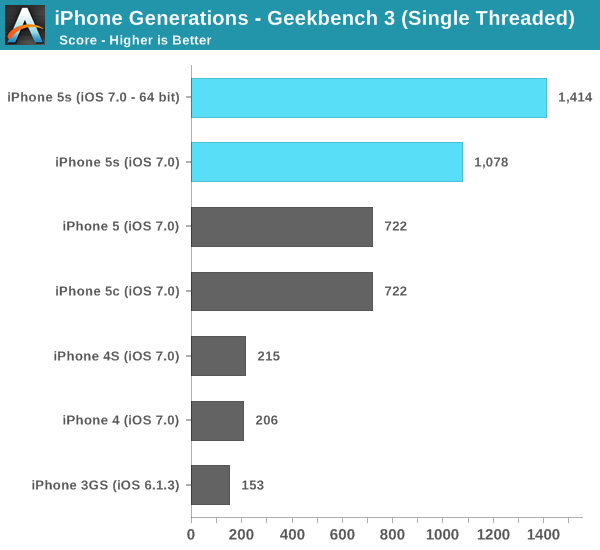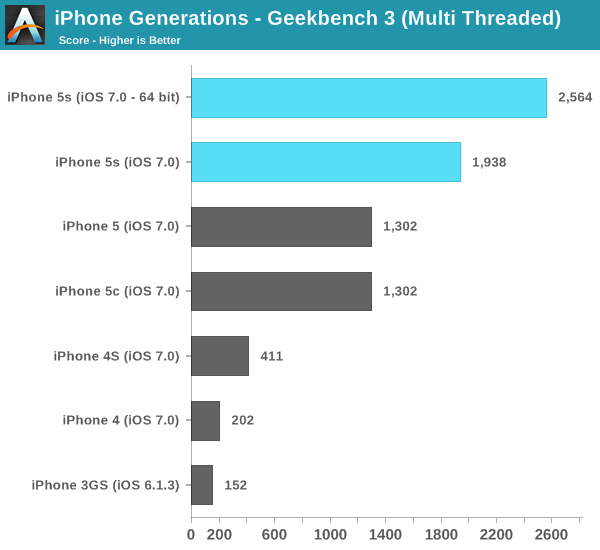The iPhone 5s Review
by Anand Lal Shimpi on September 17, 2013 9:01 PM EST- Posted in
- Smartphones
- Apple
- Mobile
- iPhone
- iPhone 5S
iPhone Performance Across Generations

Performance improved by a factor of 100x compared to the original iPhone. You can cut that in half if the iPhone could run iOS 4. Needless to say, Apple's CPU performance estimates aren't unreasonable. We've come a long way since the days when ARM11 cores were good enough.
Even compared to a relatively modern phone like the iPhone 4, the jump to a 5s is huge. The gap isn't quite at the level of an order of magnitude, but it's quickly approaching it. Using the single core iPhone 4 under iOS 7 just feels incredibly slow. Starting with the 4S things get a lot better, but I'd say the iPhone 4 is at the point now where it's starting to feel too slow even for normal consumers (at least with iOS 7 installed).

Browsermark 2.0 gives us a good indication of less CPU bound performance gains. Here we see over a 5x increase in performance compared to the original iPhone, and an 83% increase compared to the iPhone 4.
I wanted to have a closer look at raw CPU performance so I turned to Geekbench 3. Unfortunately Geekbench 3 won't run on anything older than iOS 6, so the original iPhone bows out of this test.

Single threaded performance scaled by roughly 9x from the 3GS to the iPhone 5s. The improvement since the iPhone 4/4S days is around 6.5x. Single threaded performance often influences snappiness and UI speed/feel, so it's definitely an important vector to scale across.

Take into account multithreaded performance and the increase over the 3GS is even bigger, almost 17x now.
The only 3D test I could get to reliably run across all of the platforms (outside the original iPhone) was Basemark X. Again I had issues getting Basemark X running in offscreen mode on iOS 7 so all of the tests here are run at each device's native resolution. In the case of the 3GS to 4 transition, that means a performance regression as the 3GS had a much lower display resolution to deal with.

Apple has scaled GPU performance pretty much in line with CPU performance over the years. The 5s scores 15x the frame rate of the iPhone 4, at a higher resolution too.
iPhone 5s vs. Bay Trail
I couldn't help but run Intel's current favorite mobile benchmark on the iPhone 5s. WebXPRT by Principled Technologies is a collection of browser based benchmarks that use HTML5 and js to simulate a number of workloads (photo editing, face detection, stocks dashboard and offline notes).

Granted we're comparing across platforms/browsers here, but the 5s as a platform does extremely well in Intel's favorite benchmark. The 5c by comparison performs a lot more like what we'd expect from a smartphone platform. The iPhone 5s is in a league of its own here. While I don't expect performance equalling the Atom Z3770 across the board, the fact that Apple is getting this close (with two fewer cores at that) is a testament to the work done in Cupertino.
At its launch event Apple claimed the A7 offered desktop class CPU performance. If it really is performance competitive with Bay Trail, I think that statement is a fair one to make. We're not talking about Haswell or even Ivy Bridge levels of desktop performance, but rather something close to mobile Core 2 Duo class. I've broken down the subtests in the table below:
| WebXPRT Performance (time in ms, lower is better) | ||||||
| Chrome/Mobile Safari | Photo Effects | Face Detection | Stocks | Offline Notes | ||
| Apple iPhone 5s (Apple A7 1.3GHz) | 878.9 ms | 1831.4 ms | 436.1 ms | 604.6 ms | ||
| Intel Bay Trail FFRD (Atom Z3770 1.46GHz) | 693.5 ms | 1557.0 ms | 542.9 ms | 737.3 ms | ||
| AMD A4-5000 (1.5GHz) | 411.2 ms | 2349.5 ms | 719.1 ms | 880.7 ms | ||
| Apple iPhone 5c (Apple A6 1.3GHz) | 1987.6 ms | 4119.6 ms | 763.6 ms | 1747.6 ms | ||
It's not a clean sweep for the iPhone 5s, but keep in mind that we are comparing to the best AMD and Intel have to offer in this space. I suspect part of why this is close is because both of those companies have been holding back a bit (there's no rush to build the fastest low margin parts), but it doesn't change reality.










464 Comments
View All Comments
teiglin - Wednesday, September 18, 2013 - link
There is absolutely no basis to compare the process tech between A7 and Bay Trail. We know what battery life the A7 affords the iPhone 5s, but know nothing about what sort of battery life Silvermont might provide in a smartphone form factor. If those Oscar cores are really as power-efficient as Silvermont, then yes, that'd be amazing evidence of A7's power-efficiency.Wilco1 - Wednesday, September 18, 2013 - link
Given a 2.4GHz Bay Trail in a development board already cannot keep up with the A7 at 1.3GHz (A7 beats it by a huge margin on Geekbench), there is no hope for BT-based phones. BT would need to be clocked far lower to fit in a total phone TDP of ~2W, which means it loses out even worse on performance against A7, Krait and Cortex-A15.So yes, the fact that Bay Trail is already beaten by a phone before it is even for sale is a sign of things to come. 2014 will be a hard year for Intel given 20nm TSMC will give further performance and power efficiency gains to their competitors. It all starts to sound a lot like a repeat of the old Atom...
vcfan - Wednesday, September 18, 2013 - link
"Apple's designs are superior to Intel's. and then, Intel had better watch out."first of all, its arm vs x86. and second, it was "LOLz intel cant do low power chips,arm wins", now its "but but intel is 22nm" . hilarious.
ScienceNOW - Wednesday, September 18, 2013 - link
WE have plenty of time until 5nm, by that time most likely something New will be in place to pick up where silicone leftsolipsism - Tuesday, September 17, 2013 - link
Since when is a PS4 a desktop machine? And why only look at the GPU and not at the CPU that was clearly referenced?Crono - Tuesday, September 17, 2013 - link
Ha, I love the low-light image choice of subject. :DYou have to admit, it seems like Apple learned some things from Nokia and HTC this round to improve their cameras, though the combination dual flash is pretty ingenious. I'm wondering if the other manufacturers will adopt it or stick to single LED and Xenon flashes.
StevoLincolnite - Tuesday, September 17, 2013 - link
My Lumia has dual LED flashes, the Lumia 928 has dual Xenon flashes.So it's hardly anything new when the Lumia 920 has been on the shelf for almost a year.
whyso - Tuesday, September 17, 2013 - link
My HTC raider from 2011 has dual LED flash.Ewram - Wednesday, September 18, 2013 - link
my HTC Desire HD (HTC Ace) has dual led, bought it november 2010.melgross - Wednesday, September 18, 2013 - link
I think you missed the explanation of what Apple did here. The dual flashed in the past, and in yours and other current devices are just two flashes of exactly the same type. Apple's is one cold temp flash and one warm temp flash. The camera flashes before it takes the photo, then evaluates the picture quality based on color temperature. It then comes up with a combination of flash exposure that varies the amount each flash generates so as to give the proper color rendering, and well as the correct exposure.No other camera does that. Not even professional strobes can do that. I wonder if Apple patented the electronics and software used for the evaluation.